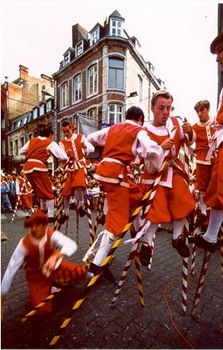Stilt Walking
Stilts are poles that allow person stand and walk at certain height above the ground. To enable walking stilts have sort of steps for the feet to stand on, or straps to attach them to the legs. Stilts have been used in many parts of Europe as people suffered from floods, had to walk through marshes etc. In the 19th century competitions in stilt walking were organized in parts of Spain and France. The best competitors won prizes like a gun or a sheep.
Nowadays stilt walking is the main attraction of several festivals. One of them is held in the small mountainous village of Anguiano. It is located in the province of La Rioja in the north of Spain. People of Anguiano organize "Danza de los Zancos" ("Stilt dancing"). The festival is held on the 22nd and 23rd of August in honour of "Magdalena" (Mary Magdalene). She is a very popular saint in this part of Spain. Eight men participating in the festival wear brightly coloured shirts and petticoats that trail down to their ankles. Each of them is standing on wooden stilts.
 Danza de los Zancos ("Stilt dancing")
Danza de los Zancos ("Stilt dancing")
The start of event is in the main village church. There dancers take a small icon of "Magadalena", go down the church and further down the street. They "dance" in spinning moves through the narrow and steep village streets. Everything is extremely dangerous. Stilt walking dancers turn in kind of trance state. They believe that the saint is protecting them. Accidents are rare. Dancers even have one village street named after them. It is the the "Cuesta de los Danzadores". The dance is finished by putting the icon in a small shrine.
The next of stilt walking festivals is organized in town of Deventer in the Overijssel province located in the east of the Netherlands. The local festival called "Deventer op stelten" ("Deventer on Stilts") is organized on the 3rd, 4th and 5th of July.
 Deventer op stelten ("Deventer on Stilts")
Deventer op stelten ("Deventer on Stilts")
In 2013 the festival will be organized for the 17th time. The festival includes dancers and acrobats on stilts. Shows are held at two main squares of Deventer - "de Brink" and "het Grote Kerkhof". For all of you planning to visit the festival it is good to know that the entrance to all shows is free.
Stilt walking festival exists in Belgium too. The festival of this kind is organized in Namur (Namen in Dutch, Nameur in Walloon) located in the south of the country. It is known as "li bia bouquet" or the gold stilt combat. It is held on the third Sunday in September.
Like in so many other things there is a legend about the festival. In the 14th century the noble John of Flanders and people were in a fight. He threatened them. One day a delegation representing the town appeared before the Duke walking on stilts. The Duke found this very amusing. So, he decided to stop the conflict.
There is another, more practical explanation about the origin of this stilt walking festival. In the Middle Ages Namur was often flooded. Walking on stilts became a way of having fun too. Young people of Namur were divided into two groups. The first one included those living in the old part of town. They called themselves "Mellans". Their stilts were yellow and black. The second one were the people living new part of town. They were "Avresses". Their stilts were red and white.
 Mellans and Avresses
Mellans and Avresses
Fights were organized between the "Mellans" and "Avresses". The fighters of each group stood in line. The battle started with the sound of drum. Each fighter tried to make the opponent fell. The used stilts and their elbows to do it. The biggest battles, with up to, 1000 fighters were organized at the St-Remy Market. The authorities often banned such events. The tradition of these battles was brought back to life in 1951. Nowadays the "Mellans" and "Avresses" often appear as guest to many festivals in other parts of the world.